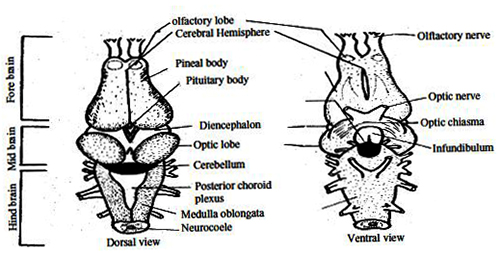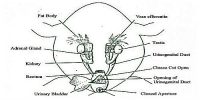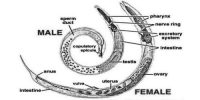The brain structure of toad is mainly divided into three parts, such as the fore brain, mid brain and hind brain.
1. Fore brain: It is the anterior-most part of the brain. The brain is the fore brain. The fore brain is again divided into two parts:
Telencephalon: It is the anterior-most part of the fore brain. It is divided into two parts such as:
- Olfactory lobe: It is a pair of out growth arising from the telencephalon of the fore brain. These growths are called olfactory lobes. It is the centre of the smell of toad.
- Cerebral hemisphere: Behind the olfactory lobes there are two cerebral hemispheres. Their function is to move the muscles and control intelligence.
Diencephalon: The comparatively small region situated behind telencephalon is the diencephalon. Its sides are swollen and there is a narrow raised portion of the dorsal side. The hormone is secreted by the pituitary body situated here. This hormone is helpful in metabolic processes, growth, attaining maturity and nutrition of reproductive cells.
2. Mid brain: The mid brain is situated in between the fore and hind brains This region is comparatively wider than the other regions. A spherical region present on the two sides of this part. It is called optic lobe. Mid brain is the centre of the vision of the toad.
3. Hind Brain: The hindbrain occupies the posterior position of the mid brain. This part extends up to the root of the spinal cord. This region of the brain is divided into two parts. Metencephalon and Myelencephalon or medulla oblongata.
Metencephalon: The narrow part just behind the optic lobes is the metencephalon. This part controls the voluntary movement of the toad.
Myelencephalon or Medulla oblongata: It is the posterior-most part of the brain which gradually narrows and meets with the spinal cord. There is an aperture behind the cranium. The medulla oblongata comes out through this aperture and meets the spinal cord. Medulla is an important region of the brain. It assists in physiological functions including capturing of prey, respiration, producing sound; taking food by the tongue, heart beat etc.















